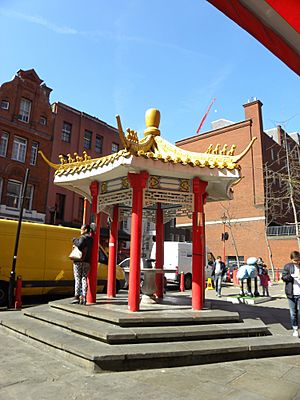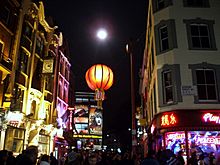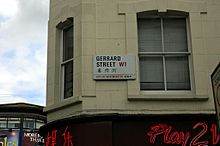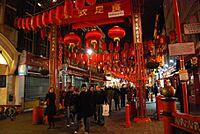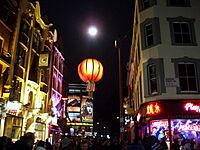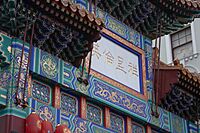Chinatown, London facts for kids
Quick facts for kids Chinatown, London
|
|
|---|---|
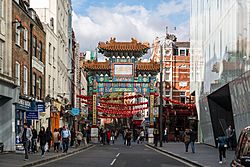 Main gate on Wardour Street |
|
| London borough | |
| Ceremonial county | Greater London |
| Region | |
| Country | England |
| Sovereign state | United Kingdom |
| Post town | LONDON |
| Postcode district | W1D |
| Dialling code | 020 |
| Police | Metropolitan |
| Fire | London |
| Ambulance | London |
| EU Parliament | London |
| UK Parliament |
|
| London Assembly | |
| London Chinatown | |||||||||||||||||
|---|---|---|---|---|---|---|---|---|---|---|---|---|---|---|---|---|---|
| Traditional Chinese | 倫敦唐人街 | ||||||||||||||||
| Simplified Chinese | 伦敦唐人街 | ||||||||||||||||
|
|||||||||||||||||
| Alternative Chinese name | |||||||||||||||||
| Traditional Chinese | 倫敦華埠 | ||||||||||||||||
| Simplified Chinese | 伦敦华埠 | ||||||||||||||||
|
|||||||||||||||||
Chinatown in London is a special area in the City of Westminster. It's like a small piece of China right in the heart of London! This vibrant neighborhood is next to Soho and Theatreland.
You'll find many Chinese restaurants, bakeries, supermarkets, and souvenir shops here. It's a popular spot for delicious food and unique cultural experiences. The main part of Chinatown is around Gerrard Street.
Contents
History of London's Chinatown
Did you know there was an earlier Chinatown in London? It was in an area called Limehouse in the East End of London. In the early 1900s, many Chinese sailors visited London's Docklands. Chinese businesses grew there to serve them.
However, much of this old Chinatown was badly damaged during World War II by bombs. After the war, Chinese food became very popular across London. Many people from Hong Kong also moved to the city. This led to new Chinese restaurants opening in different parts of London.
How the Current Chinatown Began
The Chinatown we know today, near Shaftesbury Avenue, started to grow in the 1970s. Before that, it was just a regular part of Soho. Gerrard Street was the main road. Over time, more and more Chinese restaurants and shops opened.
Today, this area has over 80 restaurants. They offer some of London's best and most real Asian food.
In 2005, a company wanted to change the eastern part of Chinatown. Many shop owners worried this would push out the traditional Chinese stores. They feared it would change the unique feel of Chinatown.
The London Chinatown Community Centre (LCCC) has been in the area since 1980. It helps many people in the Chinese community. The Centre moved to 2 Leicester Court in 2012.
Where is Chinatown?
Chinatown doesn't have exact borders, but it generally includes several streets. These are Gerrard Street, the lower part of Wardour Street, Rupert Street, and a section of Shaftesbury Avenue. It also covers Lisle Street, Macclesfield Street, Newport Place, Newport Court, and Little Newport Street.
Fun Facts About Street Names
Many streets in Chinatown have interesting names! Here are a few:
- Charing Cross Road: Built in 1887, it leads to a cross at Charing. The name "Charing" comes from an old English word for a bend in the River Thames.
- Coventry Street: Named after Henry Coventry. He was a government official for King Charles II and lived nearby.
- Gerrard Street: Named after Charles Gerard, 1st Earl of Macclesfield. He owned the land when the street was built in the 1680s.
- Great Windmill Street: Named after a large windmill that stood nearby in the 16th and 17th centuries.
- Leicester Square and nearby streets: In the 1600s and 1700s, Leicester House was here. It was built by Robert Sidney, 2nd Earl of Leicester.
- Newport Street: Named after Mountjoy Blount, Earl of Newport. He owned a house on this street in the 1600s.
- Rupert Street: Named after Prince Rupert of the Rhine. He was a famous general in the 1600s and the son of King James I's daughter.
- Shaftesbury Avenue: Named after Anthony Ashley Cooper, 7th Earl of Shaftesbury. He was a Victorian politician known for helping people.
- Wardour Street: Named after the Wardour family, who owned land here in the 1600s.
Education in Chinatown
The City of Westminster runs the Charing Cross Library. This library has a special section called the Westminster Chinese Library. It's a great place to learn more about Chinese culture and language!
Getting Around Chinatown
Public Transport
The easiest way to get to Chinatown is by using the London Underground. The closest stations are Leicester Square and Piccadilly Circus.
Parking Your Car
There is a car park right in Chinatown. It's located under Vale Royal House, a large building in Newport Court.
Gallery
-
A stone lion on Gerrard Street. Note the bilingual English/Chinese street sign in the background.
See also
 In Spanish: Chinatown (Londres) para niños
In Spanish: Chinatown (Londres) para niños



